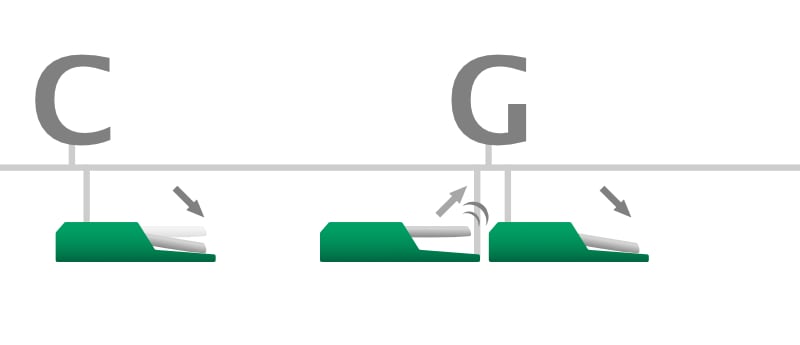Worship piano: the ultimate guide for beginners
If you’re anything like me, then you probably consider music to be one of the most amazing gifts from God. As a kid, I wasn’t always excited about attending the Sunday service, but I remember that the time of praise and worship was my favorite part of the service, and that’s also where my desire to learn worship piano was born. When looking back on my life, music has played a significant role in my walk with Christ, since it can impact us on a deeper than merely an intellectual level. Music can directly reach our hearts, and that’s why I think music is so powerful and worth learning and exploring.
Since music can be such a powerful tool used widely in a Christian’s life, I hope this article will help you learn how to start playing your very first worship songs on the piano.
This article is supposed to be comprehensive. So if you are brand new to piano and music theory, I would recommend taking your time while reading through the theoretical parts. Understanding the different concepts will help you later in your musical development.
In case you are familiar with any of the following topics, feel free to skip to the part you’re interested in.
1. The two common approaches of learning worship piano
There are many ways you can go about learning the piano. The most common one is learning how to read sheet music, which requires an understanding of notation in the bass and treble clef.
While being able to read notes is undoubtedly valuable, it can be a rather slow and lengthy process.
Another approach you can take is to learn how to play different chords on the keyboard and play songs using lyric sheets with chords. Since I find this approach a much easier, faster, and more enjoyable way of learning to play the piano, this is the method I’m going to explain in this article.
2. Learning the piano keys
One of the most important things to learn before you start playing the piano is knowing how to identify notes on the piano keyboard.
Most standard pianos have 88 keys. In case you have a keyboard or digital piano with less than that, you can read about the pros and cons of smaller keyboards in my other article here.
Even though 88 keys may seem like a lot to remember, there are, in fact, just 12 different keys. As you can see on the piano keyboard diagram below. These 12 notes repeat throughout the rest of the keyboard.
As you can see from the diagram, there are white keys and black keys.
White keys on the piano represent notes A, B, C, D, E, F, G – simple right? Since they correspond to the letters of the alphabet, remembering them should be a breeze.
Black keys on the piano are called either sharps (#) or flats (b) of its neighboring white keys. Therefore they have not one but two names, the first one being G# or Ab, second A# or Bb, third C# or Db, fourth D# or Eb, and the fifth F# or Gb. Sharps occur when you move up the keyboard, while flats occur as you move down. That’s it!
3. Understanding the major key and major scale
Now that you know where to find different notes on a piano, it’s also important to know what is a major key. To put it simply, it is a set of notes that sound well/harmoniously together. In total, we have 12 different major keys, which means there are as many major keys as there are different notes in music.
Major keys vs. major scales:
Similar to major keys are major scales. Regarding the notes they contain, they are the same. Nevertheless, both terms describe different aspects of musical theory.
Every major key and major scale consists of 7 notes. The first note of the key is called the tonic, which determines the name of the key or scale. For example, if we have a key or a scale starting with the tonic note G, it is called the G major key. All notes of the G major key are G, A, B, C, D, E, and F♯.
Generally speaking, a major key is more of an overarching term, which indicates the set of notes a song or musical piece will be built around. For example, if a song is in a key of G major, it means that the chords and melody will be written based on the notes we find in this key – G, A, B, C, D, E, and F♯.
A scale is a sequence of notes written or played from the lowest to the highest pitch. For example, G major scale is simply the sequence of notes G, A, B, C, D, E, and F♯ written or played in an ascending or descending order.
Lake vs. river
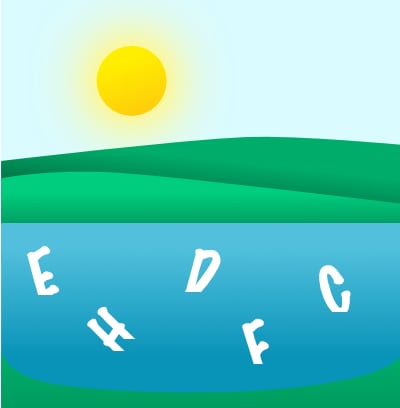
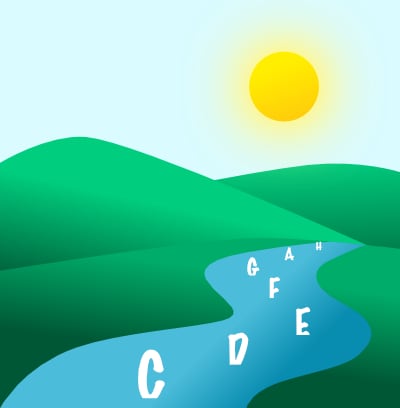
“Both a lake and a river are bodies of water, but only river flows in a particular direction. The same is true for the major key and the major scale, both include the same notes, but only in the case of scale, they “flow” in a particular order.“
Learning notes of all 12 major keys
There are two most common ways to learn the notes of all 12 major keys. You can either memorize them or learn a simple formula on how to build scales which will also tell you the notes of a given key, since major scales and major keys share the same notes.
As I mentioned earlier, every major scale consists of 7 notes. The distance between each note of the scale is called an interval. The smallest interval we can play is called half step (H), which is simply the closest note to the one we are playing (either black or white). The second important interval to know in order to build a scale is a whole step (W), consisting of two half steps.
Now that you understand the two basic intervals. Here is a formula for creating major scales: W, W, H, W, W, W, H. As an example, I built a G major scale using the rule above, where I show how the formula works.
4. Basic chords & chord progressions
Now that you know the names of the notes on the keyboard and how to play scales, you need to understand one more piece of theory, and those are chords.
Chords happen when 3 or more notes are played simultaneously. The good news is that you don’t need to know a lot of chords in order to start playing many contemporary worship songs. Actually, you can start to play knowing just 4 simple chords.
For the purpose of this lesson, we will be using 3 note chords called triads (or triadic chords).
The 4 basic worship chords are:
Name of the chord (Symbol of the chord) – Notes of the chord
G major (G) – G-B-D
C major (C) – C-E-G
D major (D) – D-F#-A
E minor (Em) – E-G-B
Tip: When playing chords, make sure to use correct finger placement. For example, when playing G major chord, play the note G with the thumb, the note B with your middle finger, and D with your pinky. By doing so, you will minimize the tension in your hand, and start forming the right habits.
Correct vs. incorrect finger placement
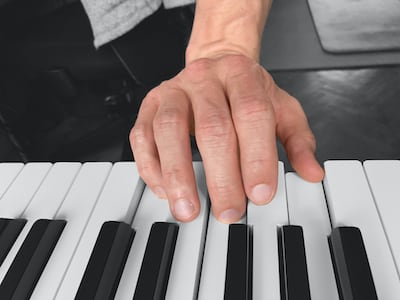
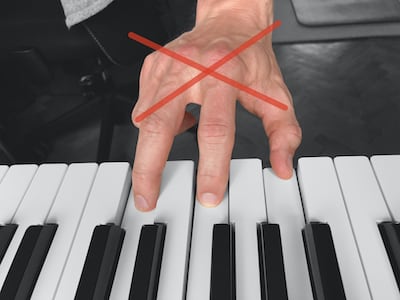
Chord progressions
As you may have already figured out a chord progression is nothing more than a sequence of 2 or more chords. Majority of worship songs are built around one or more different chord progressions, which generally tend to repeat throughout the song.
Building simple chords
Building a simple triadic chord isn’t too difficult, but it requires you to understand musical notes, intervals as well as chord formulas.
All chords are based on intervals called thirds, and there are 2 kinds of thirds:
Major third (3) – interval of 4 half steps (e.g., C -> E)
Minor third (b3) – interval of 3 half steps (e.g., E -> G)
In order to build a major chord, you need to stack a major third on top of a minor third.
In order to build a minor chord, you need to stack a minor third on top of a major third.
The second option to build triadic chords is to use a formula that will allow you to derive chords from scales.
As an example, let’s build a C major chord using a C major scale.
First, assign numbers to each note of the scale, as shown below. Then use the formula to build the chord.
| C | D | E | F | G | A | B |
| 1 | 2 | 3 | 4 | 5 | 6 | 7 |
The formula for major chords is 1 3 5
In order to build a minor chord use the following formula instead:
The formula for minor chords is 1 b3 5. The symbol “b” indicates that the 3rd note has to be lowered by a half step.
5. Playing worship songs using lyric sheets with chords
Let’s say you want to learn song 10 000 reasons by Matt Redman. First, go to Google and search for the phrase “10 000 reasons chords“. The very first results should lead you to lyric sheets with chords. Print it or save a copy on your computer, as it will serve you as a guide to follow when playing the song.
As you can see below, if we take sheet music and compare it to the chord sheet with lyrics, the difference is obvious – there is no staff or notes on our sheet.
Sheet music
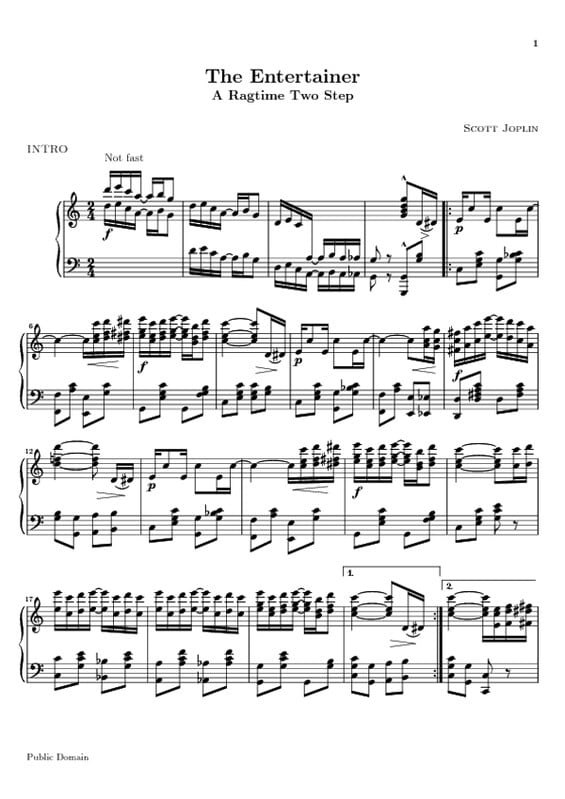
Lyric sheet with chords
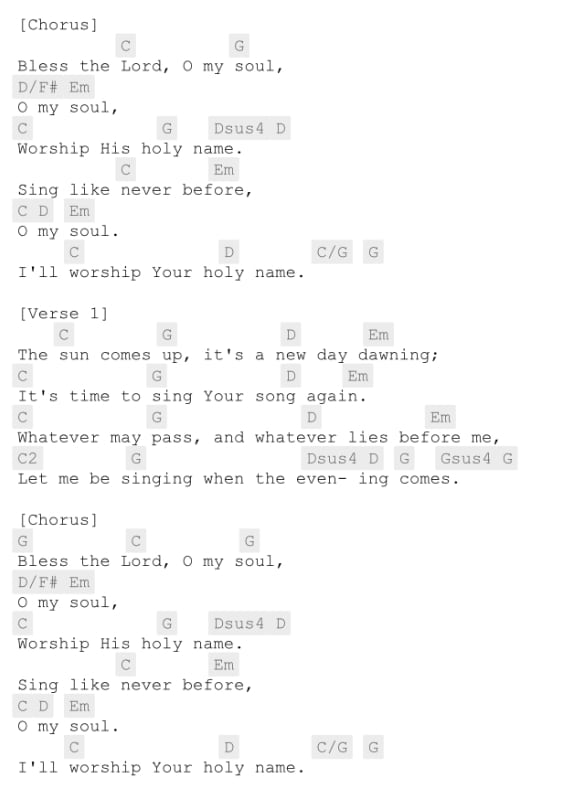
Unlike sheet music, which tends to be very precise in telling you what to play, lyrics sheets with chords are very basic. All they tell you is the chords and the moments (word/syllables) when you should play them. Since this type of written music gives us very little information about how to play the song, this approach requires you to be familiar with the song before you start learning how to play it. Additionally, it’s not uncommon to come across sheets that aren’t very accurate, so you will have to rely more on your ears to guide you when to play the different chords. Lastly, if you come across chords such as Dsus4, D/#F, C/G, etc., ignore the second part of the chord, and for now, just focus on the firs part indicating whether the chord is major or minor.
6. Playing your first worship song
Now that you’re ready with your chart printed out, you can start playing. The song is in 4/4 time signature, which tells you the rhythm of the song. A 4/4 time signature is a “cycle” of 4 beats (or four quarter notes), which repeats throughout the song and is counted | 1, 2, 3, 4 | 1, 2, 3, 4 | … . In musical terms, one “cycle” of 4 beats is called a bar or a measure.
Start with the right hand only
Practice chaning chords
In the beginning, it’s a good idea to simply practice changing chords with one hand in a slow tempo. So start singing the chorus and lay down the chords according to the phrasing of the song, as shown on the sheet. The first chord (C) of the song falls on the word “Lord.” The second chord (G) falls on the word “soul.” Continue singing and changing chords according to the sheet, pay attention to play the chords on the right syllable of the word.
TIP: Often, the first chord of the song tells us the key of the song, but not in this case. This can cause you to have a problem singing the melody. If so, start with 4 beats of G major chord to establish the key of the song in your ears.
Basic quarter note rhythm
If you’ve been practicing changing chords for a while now, and feel comfortable with it, you can try to play them with a simple quarter note rhythm with your right hand. This means you are going to play a chord on every beat of the bar. For example, the first chord of the chorus (C) is played for two beats, which means you are going to play the chord twice, following with two beats of the G chord – and that’s the first bar of the song.
Continue playing, change chords as they are noted on the sheet, make sure you are not dragging or rushing but change your chords aligned with the beat of the song.
TIP: If you have been practicing for some time, but still have a tendency to speed up or slow down, it might be a good idea to download a metronome app for your smartphone and practice playing chords with it as it will give you audible feedback. The song’s original tempo is around 72 BPM (BPM = beats per minute), but it might be a good idea to start at a slower BPM such as 60 to make yourself comfortable playing chord changes.
Add your left hand
If you’re feeling comfortable playing the song with your right hand, you can also add your left hand.
With your left hand, you want to play just two notes, not a whole chord.
The first option is to play the root note of a chord (the first note of the chord) as an octave, which means you are going to double the note with the same closest note.
The second option is to play a perfect fifth, which is basically the chord you are playing with your right hand without the middle (3rd) note.
Personally, I prefer to use perfect fifths, as in my opinion, they blend in better with chords in the right hand.
Unlike your right hand, which plays chords on every beat, with your left hand, you want to play the intervals only whenever you’re moving from one chord to the next.
Using sustain pedal
By using the sustain pedal on your piano, you can make your chord changes smooth and seamless. It’s a really nice effect that elevates your playing instantly, but it requires a bit of practice.
How to use pedal:
Let’s say the song you chose starts with a C major chord. After you play the initial chord, you want to press the pedal immediately. Than repedal while chaning the chord. By repedaling I mean lifting the pedal as you are laying down the new chord and then pressing it down again, so you are only holding the new chord you’ve just played.
Transposing songs
If you found a song you want to learn, but it’s either too high or too low for you to sing, there’s a simple solution. Most digital pianos and keyboards have a transpose function, which allows you to change the key of a song in a press of a button.
For example, if a song is in a G major key, with a transpose button, you can move the song by one or more semitones (half steps) up or down until you find the key in which you can sing comfortably.
You can also transpose songs by yourself with a bit of theory, but that’s for another lesson.
Caution:
As helpful as the function might be for beginning pianists, don’t overuse it. It might be tempting to play all songs in the key you’re most comfortable with, but in the long term, you’ll slow down your progress on the instrument.

Welcome to my blog!
Hi, I’m Kuba! Music, instruments and piano has been a big part of my life for quite some time (actually over 20 years)! I come here and write about what I’ve lerned, gear or anythings else piano related. I hope you will find this site helpful.
Other Articles
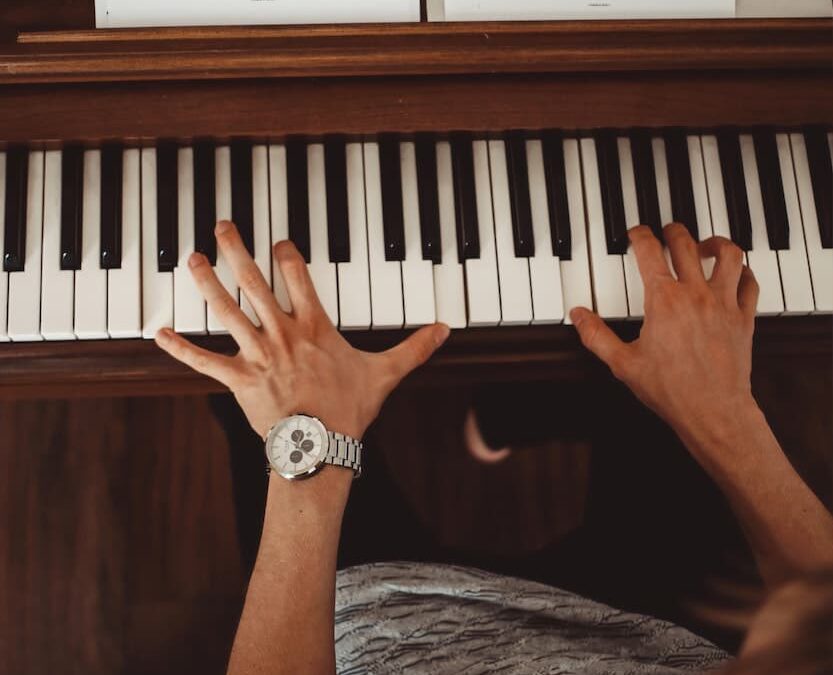
7 Ways to Make Your Chords More Interesting (tips for piano beginners)
Probably all of us face moments when we reach a plateau in our playing. Those are times when it's a good idea to seek out some inspiration to overcome the rut. If you're bored of playing the same chords over and over again, wondering how to make your chords sound more...

How to learn songs by ear
I was around 13 years old and had been thinking about quitting my piano endeavors because, for the past six years, I was almost exclusively playing classical music, which as a kid I didn't enjoy. As much as my classical training helped me develop my piano technique,...
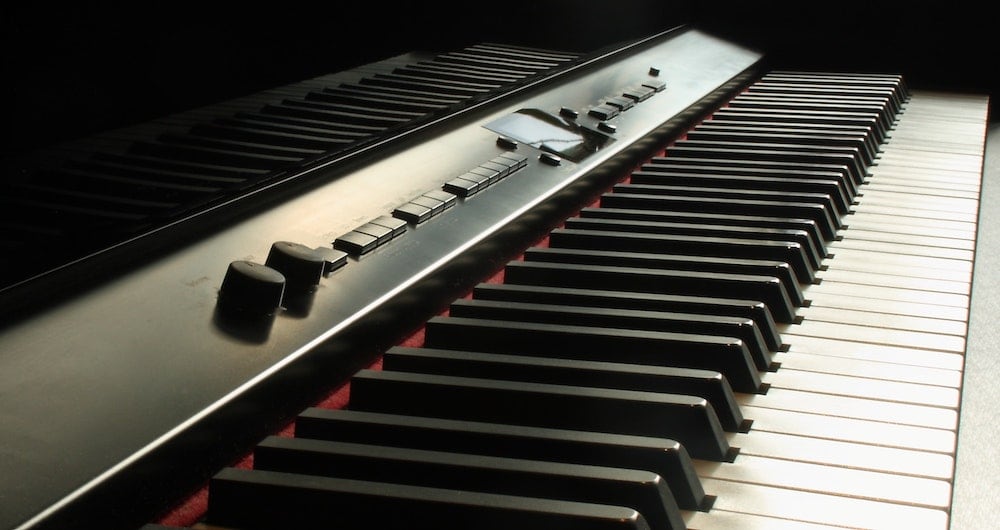
Best digital piano for church
If you are looking for a digital piano for your church, you might be wondering what are the key factors and features I should consider before the purchase? There are dozens of factors you can take into account, but not all of them are equally important.I've been...
Related Article
How to learn songs by ear
I was around 13 years old and had been thinking about quitting my piano endeavors because, for the past six years, I was almost exclusively playing classical music, which as a kid I didn't enjoy. As much as my classical training helped me develop my piano technique,...










